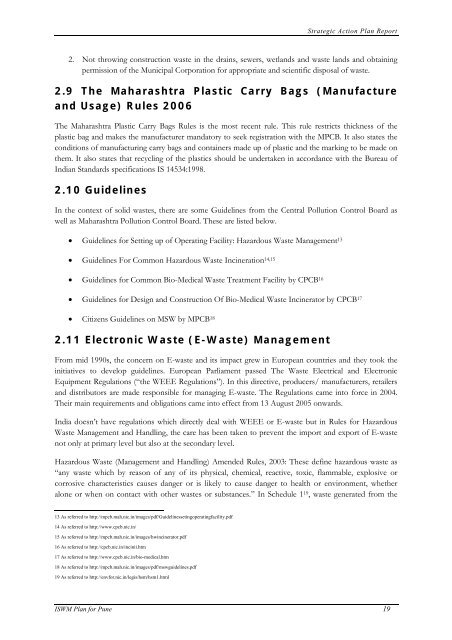Strategic Action Plan - International Environmental Technology Centre
Strategic Action Plan - International Environmental Technology Centre
Strategic Action Plan - International Environmental Technology Centre
You also want an ePaper? Increase the reach of your titles
YUMPU automatically turns print PDFs into web optimized ePapers that Google loves.
<strong>Strategic</strong> <strong>Action</strong> <strong>Plan</strong> Report<br />
2. Not throwing construction waste in the drains, sewers, wetlands and waste lands and obtaining<br />
permission of the Municipal Corporation for appropriate and scientific disposal of waste.<br />
2.9 The Maharashtra Plastic Carry Bags (Manufacture<br />
and Usage) Rules 2006<br />
The Maharashtra Plastic Carry Bags Rules is the most recent rule. This rule restricts thickness of the<br />
plastic bag and makes the manufacturer mandatory to seek registration with the MPCB. It also states the<br />
conditions of manufacturing carry bags and containers made up of plastic and the marking to be made on<br />
them. It also states that recycling of the plastics should be undertaken in accordance with the Bureau of<br />
Indian Standards specifications IS 14534:1998.<br />
2.10 Guidelines<br />
In the context of solid wastes, there are some Guidelines from the Central Pollution Control Board as<br />
well as Maharashtra Pollution Control Board. These are listed below.<br />
• Guidelines for Setting up of Operating Facility: Hazardous Waste Management 13<br />
• Guidelines For Common Hazardous Waste Incineration 14,15<br />
• Guidelines for Common Bio-Medical Waste Treatment Facility by CPCB 16<br />
• Guidelines for Design and Construction Of Bio-Medical Waste Incinerator by CPCB 17<br />
• Citizens Guidelines on MSW by MPCB 18<br />
2.11 Electronic Waste (E-Waste) Management<br />
From mid 1990s, the concern on E-waste and its impact grew in European countries and they took the<br />
initiatives to develop guidelines. European Parliament passed The Waste Electrical and Electronic<br />
Equipment Regulations (“the WEEE Regulations”). In this directive, producers/ manufacturers, retailers<br />
and distributors are made responsible for managing E-waste. The Regulations came into force in 2004.<br />
Their main requirements and obligations came into effect from 13 August 2005 onwards.<br />
India doesn’t have regulations which directly deal with WEEE or E-waste but in Rules for Hazardous<br />
Waste Management and Handling, the care has been taken to prevent the import and export of E-waste<br />
not only at primary level but also at the secondary level.<br />
Hazardous Waste (Management and Handling) Amended Rules, 2003: These define hazardous waste as<br />
“any waste which by reason of any of its physical, chemical, reactive, toxic, flammable, explosive or<br />
corrosive characteristics causes danger or is likely to cause danger to health or environment, whether<br />
alone or when on contact with other wastes or substances.” In Schedule 1 19 , waste generated from the<br />
13 As referred to http://mpcb.mah.nic.in/images/pdf/Guidelinessetingoperatingfacility.pdf<br />
14 As referred to http://www.cpcb.nic.in/<br />
15 As referred to http://mpcb.mah.nic.in/images/hwincinerator.pdf<br />
16 As referred to http://cpcb.nic.in/incinii.htm<br />
17 As referred to http://www.cpcb.nic.in/bio-medical.htm<br />
18 As referred to http://mpcb.mah.nic.in/images/pdf/mswguidelines.pdf<br />
19 As referred to http://envfor.nic.in/legis/hsm/hsm1.html<br />
ISWM <strong>Plan</strong> for Pune 19
















